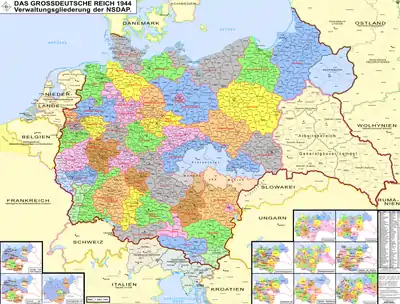Gau Thuringia
The Gau Thuringia (German: Gau Thüringen) formed on 6 April 1925, was an administrative division of Nazi Germany in the Free State of Thuringia from 1933 to 1945. Before that, from 1925 to 1933, it was the regional subdivision of the Nazi Party in that area.
| Gau Thuringia | |||||||||||||
|---|---|---|---|---|---|---|---|---|---|---|---|---|---|
| Gau of Nazi Germany | |||||||||||||
| 1925–1945 | |||||||||||||
.svg.png.webp) Flag
.svg.png.webp) Coat of arms
| |||||||||||||
 Map of Nazi Germany showing its administrative subdivisions (Gaue and Reichsgaue). | |||||||||||||
| Capital | Weimar | ||||||||||||
| Government | |||||||||||||
| Gauleiter | |||||||||||||
• 1925–1927 | Artur Dinter | ||||||||||||
• 1927–1945 | Fritz Sauckel | ||||||||||||
| History | |||||||||||||
| 6 April 1925 | |||||||||||||
| 8 May 1945 | |||||||||||||
| |||||||||||||
| Today part of | |||||||||||||
History
The Nazi Gau (plural Gaue) system was originally established in a party conference on 22 May 1926, to improve administration of the party structure. From 1933 onwards, after the Nazi seizure of power, the Gaue increasingly replaced the German states as administrative subdivisions in Germany.[1]
At the head of each Gau stood a Gauleiter, a position which became increasingly more powerful, especially after the outbreak of the Second World War, with little interference from above. Local Gauleiters often held government positions as well as party ones and were in charge of, among other things, propaganda and surveillance and, from September 1944 onward, the Volkssturm and the defense of the Gau.[1][2]
The position of Gauleiter in Thuringia was originally held by Artur Dinter. On 30 September 1927 Fritz Sauckel took over as Gauleiter and held this position until the end of the war. Sauckel also served as the Reich General Plenipotentiary for Labor. He was convicted at the Nuremberg trials and executed for war crimes on 16 October 1946.[3] His deputies were Willy Marschler (1927–32), Fritz Wächtler (1932–35) and Heinrich Siekmeier (1936–45).[4]
The Buchenwald concentration camp was located in the Gau Thuringia. Of the 238,980 prisoners that were sent to the camp 43,045 were killed.[5]
References
- "Die NS-Gaue" [The Nazi Gaue]. dhm.de (in German). Deutsches Historisches Museum. Retrieved 24 March 2016.
- "The Organization of the Nazi Party & State". nizkor.org. The Nizkor Project. Retrieved 26 March 2016.
- "Gau Thüringen". verwaltungsgeschichte.de (in German). Retrieved 24 March 2016.
- "Übersicht der NSDAP-Gaue, der Gauleiter und der Stellvertretenden Gauleiter zwischen 1933 und 1945" [Overview of Nazi Gaue, the Gauleiter and assistant Gauleiter from 1933 to 1945]. zukunft-braucht-erinnerung.de (in German). Zukunft braucht Erinnerung. Retrieved 24 March 2016.
- "Buchenwald" (PDF). yadvashem.org. Yad Vashem. Retrieved 31 March 2016.